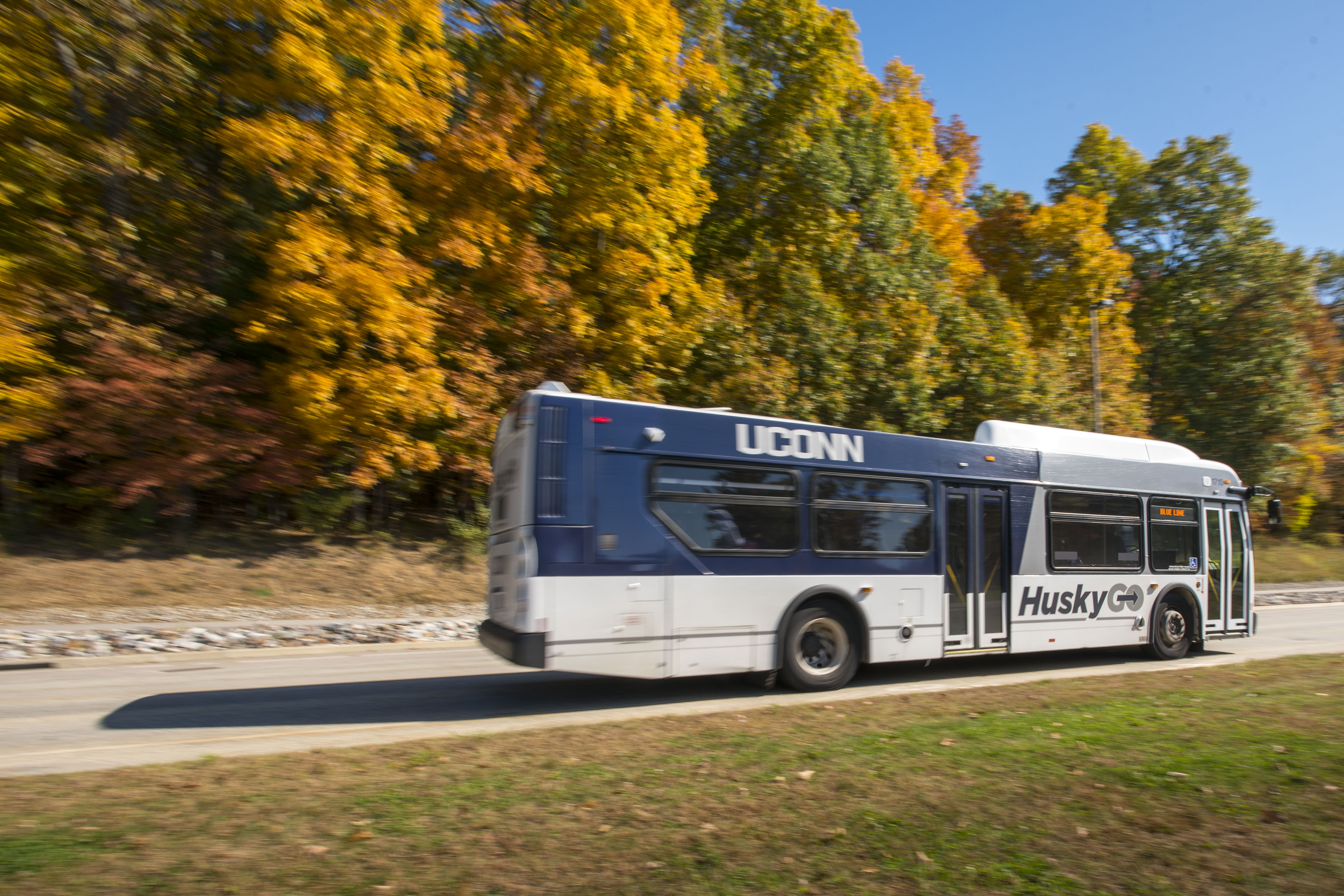UConn is partnering with state and regional transportation officials on a plan in which the University will save money by turning over operations of its campus bus service and welcoming environmentally friendly electric buses on some routes.
The University has been working with the Connecticut Department of Transportation (DOT) and Windham Regional Transit District (WRTD) on the agreement, in which WRTD recently started operating the on-campus bus service at UConn Storrs.
UConn officials presented an overview Wednesday to the UConn Board of Trustees, which approved the agreement to transfer UConn’s diesel buses to the state DOT and the on-campus shuttle services to WRTD.
For the University, it saves money that otherwise would have been needed to repair and replace buses, and operate the system; for students, access to the campus and regional bus routes has continued at no additional cost and without interruption.
While long discussed, the partnership agreement solidified when the University received a state Department of Energy and Environmental Protection (DEEP) grant award worth $1.3 million to purchase two electric buses and charging infrastructure in late 2018. It was then that UConn learned that only DOT possessed the technical expertise and proficiencies needed to maximize benefits of that grant award.
Under the agreement, UConn is transferring its 19 full-size, 35-foot passenger bus fleet to the DOT. UConn will also transfer the two full-electric buses awarded by the grant to the DOT for inclusion in their own electric bus procurement, in essence transferring the grant funding to the state agency.
The DOT will subsequently be responsible for maintaining and replacing those buses. The DOT plans to gradually replace the remaining low-sulfur diesel buses of UConn’s former fleet with fully electric transit buses, a project that otherwise would have cost UConn more than $3 million annually over the next several years.
Turning over operations to WTRD will also save the University the expense of running its own transit system, including the multi-million dollar costs of repairing and replacing buses; hiring and managing drivers; running its own dispatch center; and employing its own transit administrator.
WRTD runs the local public bus service for the region that includes 10 towns, including some bordering UConn. It receives its funding from those communities, the state DOT, the Federal Transit Administration, fares, and advertising.
The new agreement with the DOT directs UConn’s former buses to the WRTD for use within the University’s service area and will eventually add three electric buses to the WRTD’s fleet as part of DOT’s work toward establishing a statewide electric bus fleet.
As part of the transfer, the DOT will provide two electric buses for WRTD’s use within the UConn service area, and will work with UConn to plan for installing the appropriate charging stations on campus, at WRTD’s maintenance facility, or in both locations.
Those operational payments will include a 50% subsidy of the transit district general manager’s salary to ensure the University retains a voice in the management and operation of its on-campus routes and other matters.
The UConn-branded buses – which have bike racks, USB ports, and the ability to lower to help people get on and off more easily — still circulate on campus routes, albeit under WRTD’s management rather than the University’s.
The state DOT also added safety barriers to help shield drivers as part of protection against the spread of COVID-19, and cleans and sanitizes the vehicles each day, as UConn and other transit providers do.
The agreement with the state DOT and WRTD is the latest in a series of changes that UConn has established to promote efficiencies in transportation and other facilities operations, saving money while also partnering with the state to improve mass transit options near its campuses.
For instance, UConn and WRTD established another agreement last summer under which WRTD took over the Hunting Lodge Road route near the Storrs campus.
And in 2017, UConn worked with the DOT to promote the launch of the state’s CTtransit Route 913 service, which connects UConn Storrs with downtown Hartford and multiple stops in between. That route and all other public bus and train services are free to students to ride with the free U-Pass.
UConn also worked with the DOT last summer when the CTtransit system established service between the Stamford Transportation Center and UConn Stamford, allowing the University to end its shuttle bus service there and save those expenses.
“We are thrilled to see this partnership deepen,” Dennis Solensky, Public Transit Administrator for the state DOT, says of the connections and the new UConn/WRTD agreement.
“By combining the resources of these state-funded organizations, we are going to improve mobility for everyone on campus and in the region,” he says, adding that UConn “is a world-class organization” and that the University and DOT work together very well on this and other transit issues.
UConn continues to fund and independently operate the ADA paratransit services for the UConn service area through its Accessible Van Services (AVS) program.



